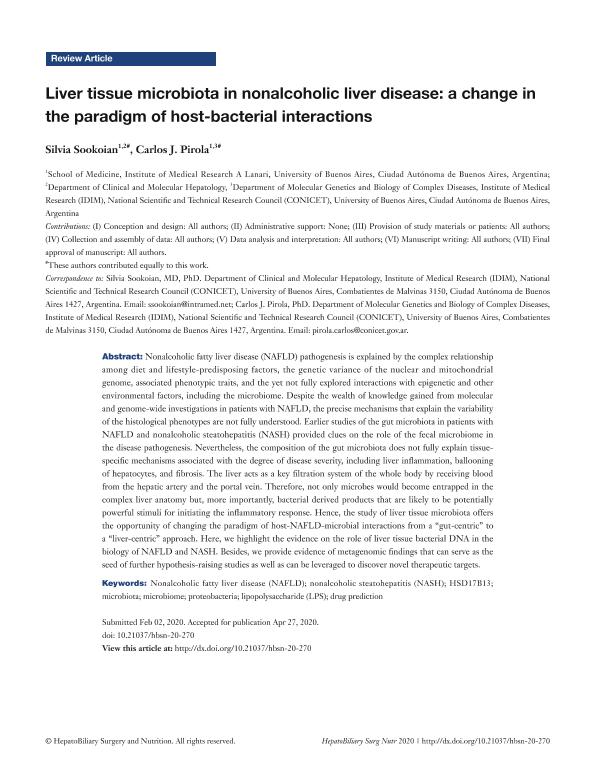Mostrar el registro sencillo del ítem
dc.contributor.author
Sookoian, Silvia Cristina

dc.contributor.author
Pirola, Carlos José

dc.date.available
2020-10-29T14:53:50Z
dc.date.issued
2020-08
dc.identifier.citation
Sookoian, Silvia Cristina; Pirola, Carlos José; Liver tissue microbiota in nonalcoholic liver disease: a change in the paradigm of host-bacterial interactions; AME Publishing Company; Hepatobiliary Surgery and Nutrition; 8-2020; 1-13
dc.identifier.issn
2304-3881
dc.identifier.uri
http://hdl.handle.net/11336/117149
dc.description.abstract
Nonalcoholic fatty liver disease (NAFLD) pathogenesis is explained by the complex relationship among diet and lifestyle-predisposing factors, the genetic variance of the nuclear and mitochondrial genome, associated phenotypic traits, and the yet not fully explored interactions with epigenetic and other environmental factors, including the microbiome. Despite the wealth of knowledge gained from molecular and genome-wide investigations in patients with NAFLD, the precise mechanisms that explain the variabilityof the histological phenotypes are not fully understood. Earlier studies of the gut microbiota in patients with NAFLD and nonalcoholic steatohepatitis (NASH) provided clues on the role of the fecal microbiome in the disease pathogenesis. Nevertheless, the composition of the gut microbiota does not fully explain tissuespecific mechanisms associated with the degree of disease severity, including liver inflammation, ballooning of hepatocytes, and fibrosis. The liver acts as a key filtration system of the whole body by receiving bloodfrom the hepatic artery and the portal vein. Therefore, not only microbes would become entrapped in the complex liver anatomy but, more importantly, bacterial derived products that are likely to be potentially powerful stimuli for initiating the inflammatory response. Hence, the study of liver tissue microbiota offers the opportunity of changing the paradigm of host-NAFLD-microbial interactions from a ?gut-centric? to a ?liver-centric? approach. Here, we highlight the evidence on the role of liver tissue bacterial DNA in the biology of NAFLD and NASH. Besides, we provide evidence of metagenomic findings that can serve as the seed of further hypothesis-raising studies as well as can be leveraged to discover novel therapeutic targets.
dc.format
application/pdf
dc.language.iso
eng
dc.publisher
AME Publishing Company
dc.rights
info:eu-repo/semantics/openAccess
dc.rights.uri
https://creativecommons.org/licenses/by-nc-nd/2.5/ar/
dc.subject
NAFLD
dc.subject
NASH
dc.subject
MICROBIOTA
dc.subject
TISSUE MICROBIOTA
dc.subject.classification
Gastroenterología y Hepatología

dc.subject.classification
Medicina Clínica

dc.subject.classification
CIENCIAS MÉDICAS Y DE LA SALUD

dc.title
Liver tissue microbiota in nonalcoholic liver disease: a change in the paradigm of host-bacterial interactions
dc.type
info:eu-repo/semantics/article
dc.type
info:ar-repo/semantics/artículo
dc.type
info:eu-repo/semantics/publishedVersion
dc.date.updated
2020-10-14T21:22:12Z
dc.identifier.eissn
2304-389X
dc.journal.pagination
1-13
dc.journal.pais
Hong Kong

dc.description.fil
Fil: Sookoian, Silvia Cristina. Consejo Nacional de Investigaciones Científicas y Técnicas. Oficina de Coordinación Administrativa Houssay. Instituto de Investigaciones Médicas. Universidad de Buenos Aires. Facultad de Medicina. Instituto de Investigaciones Médicas; Argentina
dc.description.fil
Fil: Pirola, Carlos José. Consejo Nacional de Investigaciones Científicas y Técnicas. Oficina de Coordinación Administrativa Houssay. Instituto de Investigaciones Médicas. Universidad de Buenos Aires. Facultad de Medicina. Instituto de Investigaciones Médicas; Argentina
dc.journal.title
Hepatobiliary Surgery and Nutrition
dc.relation.alternativeid
info:eu-repo/semantics/altIdentifier/url/http://hbsn.amegroups.com/article/view/46389
Archivos asociados
